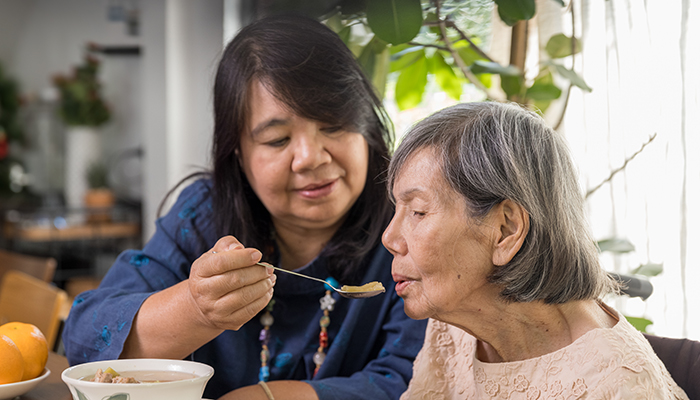Journey in Caregiving
Helpful tips for family caregivers
January/February 2023
If you are the person in your family who takes primary responsibility for the care of an aging relative, you may sometimes feel you are all alone. It’s important to reach out and get help. It’s too much to do on your own. In our middle article we help you avoid extra charges—and confusion!—as you seek to schedule wellness care for your loved one. Last, we look at the profound shortage of paid caregivers. Have you felt the impact of the “Great Resignation”?
Are you the primary caregiver?
In most families, there is one person who takes on the lion’s share of caring for an aging loved one. Perhaps it’s the oldest daughter. Or the emotionally closest child. Or maybe it’s the geographically closest relative. And when there are no siblings, it’s usually the only child.
Being primary can be quite a job. In many cases it involves driving to the doctor and managing medications, handling finances, providing for daily needs, coordinating care services, and keeping the elder’s spirits up. If you are that person, don’t try to do it alone—even if it seems like that’s the only choice.
Here is advice from family caregivers who have been through this journey:
- Take breaks. It may not feel possible, but there are ways. If you forgo breaks, you risk burning out—which has negative consequences for everyone, not just you.
- Call a family meeting to discuss sharing responsibilities. Old family dynamics often resurface in this context. Consider getting the services of a social worker or care manager to facilitate a discussion.
- Be open to receiving help. Some families complain that the primary caregiver is so particular, there isn’t a realistic way to pitch in. Does that ring even a small bell with you? You may feel that you are the only one who can do it right or that you have to do it all. Now is a time to challenge that belief about yourself, even if you are an only child.
- What if it isn’t perfect? Of course, you want the best for your loved one. But consider for a moment: What is the worst that could happen if things weren’t done exactly up to the standard that you set? Perhaps there would be some discomfort for you and your relative, but nothing compared to how bad it would be if you burned out or ended up with a health crisis of your own (not uncommon among primary caregivers).
- Be clear about the costs and the rewards. What are you sacrificing as you carry out this role? (Social life? Career advancement? Your own retirement security?) What do you realistically enjoy or gain? Identifying the pluses and minuses can help you focus on what needs changing and what you want to emphasize.
- Family patterns die hard. Guilt or the perennial desire for parental approval can wear you down quickly! Plus, it’s common for siblings to revert to old resentments and rivalry during the eldercare years. Don’t get hijacked by the past! From your adult self, acknowledge what you realistically can and can’t do. Get professional help if it’s proving too difficult to reset internally.
The yearly "Wellness Visit"
Catching things early is big with Medicare. Every year, all Medicare enrollees are eligible for a free “Wellness Visit” with their primary care doctor.
This is NOT an annual physical, so don’t use that term when making the appointment. Beyond basic vitals—height, weight, blood pressure, and pulse—there is no physical examination. If a physical exam is done, your loved one may have to foot the bill.
The yearly Wellness Visit is more of a conversation. The goal is to look at ways to avoid health problems or identify them early. The visit includes
- a review of medications and medical history
- a health risk questionnaire. This survey addresses lifestyle issues such as smoking, alcohol, and exercise
- other questionnaires assess memory and thinking problems, depression, anger, and social isolation
Based on your relative’s responses, the doctor may recommend screening tests. The idea is to nip any problems in the bud. It is also a time for your loved one to discuss preferences for end-of-life care. (This is called “advanced care planning.”)
Important to note, this visit does NOT include treatment or management of your relative’s chronic conditions. Diabetes, high cholesterol, and high blood pressure certainly threaten wellness. But they are addressed separately. And tempting as it is to say, “While I’m here, doc, what about this pain in my knee,” that is also outside the bounds. Best to make another appointment or your loved one may be charged for the visit.
Different from the “Welcome to Medicare” visit
If this is your relative’s very first year on Medicare, they are entitled to a free “Welcome Visit.” This is similar to the Wellness Visit but includes other assessments. One for fall risks. Another to identify weight problems. The appointment may also address hearing and vision. These additional assessments are not part of the yearly Wellness Visit.
Where are the paid caregivers?

Frustrated in your search for a paid caregiver? You are not alone. There is an extreme shortage of helpers right now. Even before COVID, the demand for aides was greater than the supply. The “Great Resignation” hit the caring professions hard. Caregivers close to retirement left early. And many younger workers decided to opt for safer, less demanding jobs. In some states, as many as 38% of direct-care workers chose other occupations last year.
Caregiving is strenuous work, usually for very low pay. And there’s little societal respect for the career. The work can involve unpleasant personal care tasks. As well, clients with dementia may behave unkindly. Even clients without memory and thinking problems have been known to take out frustrations on paid helpers.
Adding to those realities, there is little growth opportunity for direct-care workers. Even jobs at fast-food chains pay better. Corporate employers can also provide more-flexible schedules so parents can be home after school. All these factors make direct care a less appealing career choice. Nearly half of paid caregivers quit within their first year.
By 2030 we will have twice as many people over 65 as we had in 2011. And we will have fewer young people in the population, so fewer potential helpers.
Yikes! As a family in need of help, this can be distressing news. As many as 85% of home-care companies reported having to turn away new clients at least once because they didn’t have the staff.
If you are lucky enough to get help, strive to make it a lasting relationship. Don’t tolerate poor work, but make an effort to thank and treat with respect those aides who do good work. It will be in your best interest, and in your loved one’s. The shortage is very real.
Return to top


